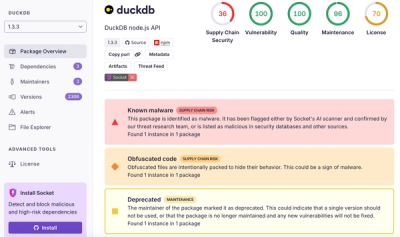
Security News
Feross on Risky Business Weekly Podcast: npm’s Ongoing Supply Chain Attacks
Socket CEO Feross Aboukhadijeh joins Risky Business Weekly to unpack recent npm phishing attacks, their limited impact, and the risks if attackers get smarter.
@vizir/idempotent-aws-lambda
Advanced tools
A fast way to turn your aws lambda function idempotent.
This library is design to resolve the idempotent problem of the AWS Lambda.
Some kind of request into AWS lambda should run most than one time, generating inconsistency problems when your function isn't idempotent. You can check more details into aws knowledge center
$ npm install @vizir/idempotent-aws-lambda
Use the default aws request id to avoid duplicate requests:
module.exports.handler = idempotencyHttpWrapper({
handler: async (event, context) => {
// Your lambda functions goes here
console.log("Processing message", event, context);
// The return will be cached into provider
return "OK";
},
provider: {
endpoint: "http://localhost:8000", // used for local development only
name: "dynamoDB",
region: "us-east-1",
tableName: "my-idempotent-table",
},
ttl: 5, // ttl in seconds
id: {
from: "requestId",
},
});
Use the request header to extract the idempotency id.
module.exports.handler = idempotencyHttpWrapper({
handler: async (event, context) => {
// Your lambda functions goes here
console.log("Processing message", event, context);
// The return will be cached into provider
return "OK";
},
provider: {
endpoint: "http://localhost:8000", // used for local development only
name: "dynamoDB",
region: "us-east-1",
tableName: "my-idempotent-table",
},
ttl: 5, // ttl in seconds
id: {
from: "header",
name: "myIdempotencyHeader",
},
});
Use the request header to extract the idempotency id (with aws request id when header is empty):
module.exports.handler = idempotencyHttpWrapper({
handler: async (event, context) => {
// Your lambda functions goes here
console.log("Processing message", event, context);
// The return will be cached into provider
return "OK";
},
provider: {
endpoint: "http://localhost:8000", // used for local development only
name: "dynamoDB",
region: "us-east-1",
tableName: "my-idempotent-table",
},
ttl: 5, // ttl in seconds
id: {
from: "header",
name: "myIdempotencyHeader",
fallback: true,
},
});
Prevent duplicate calls into sqs trigger. The ttl cannot be high to avoid retry problems.
The own aws can call your lambda twice, in this case we will ignore and remove from SQS.
There are two ways to handle the idempotency SQS.
One is as follow the example bellow, which means the idempotency key will be the messageId from SQS.
module.exports.sqsHandler = idempotencySQSWrapper({
handler: async (event, context) => {
console.log("Processing message", event, context);
return "OK";
},
provider: {
endpoint: process.env.ENDPOINT,
name: "dynamoDB",
region: process.env.REGION,
tableName: process.env.TABLE_NAME,
},
queue: {
region: process.env.REGION,
url: process.env.QUEUE_URL,
},
ttl: 5,
});
Another way is customizing the idempotency's key, from the payload of the received message.
Let's suppose the message's body is
stream: { eventType: 'SENT', id: '1234567890' }
The idempotency's configuration will be:
module.exports.sqsHandler = idempotencySQSWrapper({
handler: async (event, context) => {
console.log("Processing message", event, context);
return "OK";
},
provider: {
endpoint: process.env.ENDPOINT,
name: "dynamoDB",
region: process.env.REGION,
tableName: process.env.TABLE_NAME,
},
queue: {
region: process.env.REGION,
url: process.env.QUEUE_URL,
},
ttl: 5,
id: {
from: "event",
name: ["stream.id", "stream.eventType"],
},
});
The result in the table will be a recod, which the key will be: 1234567890SENT.
Tested in Node.js 10-12.
FAQs
A fast way to turn your aws lambda idempotent.
We found that @vizir/idempotent-aws-lambda demonstrated a not healthy version release cadence and project activity because the last version was released a year ago. It has 2 open source maintainers collaborating on the project.
Did you know?

Socket for GitHub automatically highlights issues in each pull request and monitors the health of all your open source dependencies. Discover the contents of your packages and block harmful activity before you install or update your dependencies.

Security News
Socket CEO Feross Aboukhadijeh joins Risky Business Weekly to unpack recent npm phishing attacks, their limited impact, and the risks if attackers get smarter.

Product
Socket’s new Tier 1 Reachability filters out up to 80% of irrelevant CVEs, so security teams can focus on the vulnerabilities that matter.

Research
/Security News
Ongoing npm supply chain attack spreads to DuckDB: multiple packages compromised with the same wallet-drainer malware.